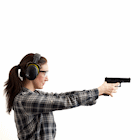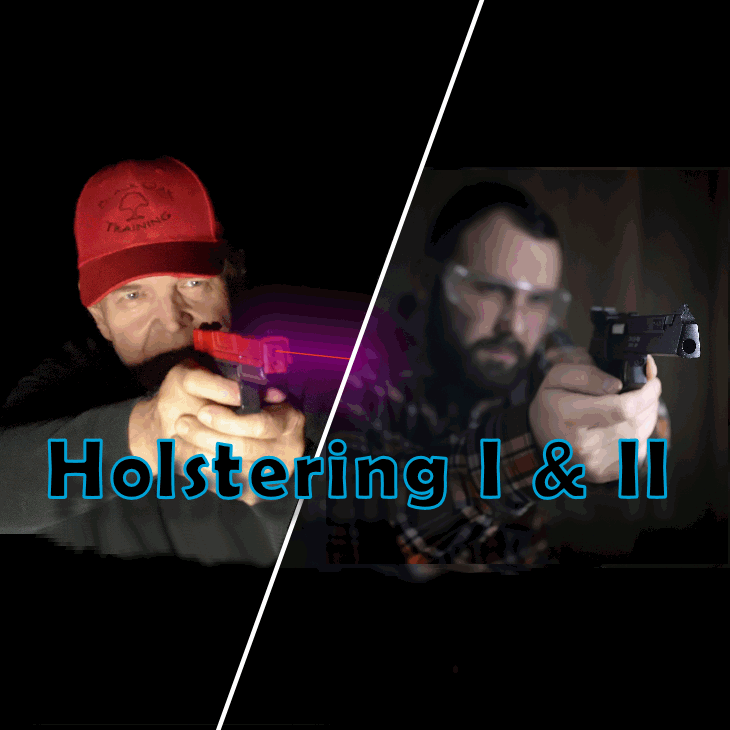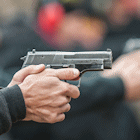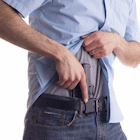What's here:

The minute you started thinking about acquiring a gun and learning how to use it you probably found yourself on the receiving end of a whole lot of information, coming at you fast and mostly not very organized from your perspective. We know this sometimes can feel like trying to sip from a firehose. (We were new at this once upon a time, too.)
Here's a kind of self-paced game plan that might help. It's a trajectory that can move you from the point of "Gosh, I think I might want to get a gun" into being a knowledgable, skilled, law-abiding California citizen who owns and can safely use a gun, and even (if this is your goal) one who is licensed and ready to carry a concealed weapon in defense of self and family.
We used to teach a class called "Real Basics." Over time, as people asked more and more questions and the answers were incorporated into the material, the class got big and naturally divided itself into two kinds of information: classroom stuff and range stuff.
We now call the classroom session New Shooter I. It includes an hour or so of discussion, Q&A, universal safety guidelines, and a hands-on session with several types of (unloaded) handguns to check for a good fit for your hand size, hand strength, life style, and objectives. (It's one thing to be interested in a gun for competitive shooting, and quite another to be seeking a tool for self, family, and home defense.) This session will bring you to the point of having enough information to select the right tool for the job. This class is $40.
 Your first live-fire range session.
Your first live-fire range session.
The range session now is a class called New Shooter II. This class generally follows New Shooter I after a few weeks, once you've had a chance to take your decisions to a Federally licensed firearms dealer (called an FFL: Federal Firearems Licensee) and make a purchase... and then get through the waiting period. This class takes place at a live-fire range, in what for many is their first trip to such an environment. It's custom-built for those who might come to their first experience at a live-fire ranges with some trepidation. You'll be under the care of your instructor and Range Safety Officer.
This is your day to fire the gun, possibly for the first time, and to see where you are in terms of natural marksmanship skills. You'll get individualized analysis and coaching. You'll also be given drills and skills with which to proceed as informed and responsible gun owners.
New Shooter II is $55 including materials fee. While few people feel the need to repeat New Shooter I, New Shooter II is a class you can repeat as often as you feel would help you.
After these two classes people usually want a period of practice on their own (hopefully in the company of one or more calm, experienced friends who shoot). If you want more structure to this period, we offer a class called Marksmanship Tuneup. This is a flexible, individualized session that again takes a look at your current skill levels and moves those up a notch -- often several notches. We find people often take this one again just before a competition or when they're about to renew their CCW. Again, this is $55 including materials fee, and can be repeated as often as you find useful.
If your objective is to target shoot now and then and to actually carry only on your own property, you're good at this point. If the local range at which you plan to practice identifies itself as "an NRA range," meaning that the organization adheres to the range rules of the National Rifle Association, you might at some point be interested in becoming certified as a Range Safety Officer (RSO). We teach the NRA's RSO class as well. This class has prerequisites, so read the description.
If you do plan to go further than target shooting and strictly at-home carry, the logical next step may be getting your license to "carry a concealed weapon" (a CCW). CCWs are administered by the Sheriff of each county, so you'll need to apply with your Sheriff and take a class by an approved provider for that county. (Black Oak Training is authorized by the Sheriffs of Butte, Nevada, and Tehama counties.) The Initial CCW class is a minimum of eight hours of instruction. You'll renew your license every two years by taking and passing the CCW Renewal class, which is a minimum of four hours.
CCW is another class with a number of prerequisites, including an application process with a background check, and the time all of this takes. Be sure to read the class description.
(BTW if you travel, once you pass our CCW class the rules of reciprocity among U.S. states can qualify you for up to 33 additional states. We'll talk a little more about that in class.
 IF you go for a CCW, be sure you train in how to draw.
IF you go for a CCW, be sure you train in how to draw.
It would be worse than pointless to carry, even in a top-notch holster, without learning and practicing how to execute a smooth, safe (to you) presentation in time to make a difference. You'd be walking around emitting that ephemeral glow generated by the delusion of readiness, rather than actually being rock solid and ready.
Different holster types (e.g., waistline, pocket, shoulder, belly-band, ankle; not to mention gun purses, holsters sewn in to items of clothing, and more), and differing holster materials can even require different techniques. Likewise, different cover garments (e.g., a sweatshirt versus an open jacket) all have their own workarounds for quick access.
Once you have your CCW, think seriously about our holstering classes (Holstering I and Holstering II) to learn how to draw from your particular setup. In Holstering I you'll work with laser ammo to safely learn, and drill, the seven-step process of drawing a gun. We provide exercises that you can do at home with an unloaded gun, because these are skills that you should practice to the same degree that you practice hitting a target. In Holstering II we meet at the range for live-fire practice. Holstering I is $40, Holstering II is $60 including the materials fee for a live-fire class. Either classes can be repeated as often as you find useful, but Holstering I is required before going on to Holstering II.
 Wrapping it up.
Wrapping it up.
We schedule our classes often and flexibly and can work around your work, school, childcare, and eldercare needs. Check out our calendar for currently planned classes; if something says OPEN then it's, y'know, open, meaning that in most cases we can refit it to your needs. Contact us with questions and requests.
Contact us when ready!
Black Oak Training is in upper Magalia, California
530-624-1562, text OK
info@BlackOakTraining.com
Contact us to arrange for a video chat
P.O. Box 1731, Magalia CA 95954


